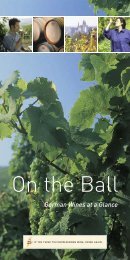the magazine of the german wine institute - Wines of Germany
the magazine of the german wine institute - Wines of Germany
the magazine of the german wine institute - Wines of Germany
Create successful ePaper yourself
Turn your PDF publications into a flip-book with our unique Google optimized e-Paper software.
50 THE BIOGRAPHY OF WINE<br />
The biography <strong>of</strong> <strong>wine</strong><br />
Wine and people have something in common: <strong>the</strong>ir biography makes <strong>the</strong>m into individuals. Not just <strong>the</strong> grape<br />
variety and its geographic origin – soil and climate at <strong>the</strong> vineyard location – but also <strong>the</strong> processing in <strong>the</strong> cellar are<br />
critical factors which shape every <strong>wine</strong>. To continue <strong>the</strong> metaphor <strong>of</strong> <strong>the</strong> biography (by <strong>the</strong> way, connoisseurs swear<br />
that <strong>wine</strong> is “alive”!): The childhood in <strong>the</strong> vineyard is followed by <strong>the</strong> youth in <strong>the</strong> cellar. Grown up, <strong>the</strong> <strong>wine</strong> ends<br />
up in <strong>the</strong> bottle with <strong>the</strong> consumer and may perhaps mature some more in his cellar to become a senior. So what<br />
does <strong>the</strong> course <strong>of</strong> life <strong>of</strong> a <strong>wine</strong> look like?<br />
In <strong>the</strong> beginning was <strong>the</strong> vineyard<br />
Every gardener knows that some plants<br />
need sun while o<strong>the</strong>rs prefer shade. Types<br />
<strong>of</strong> vine also have different requirements<br />
for <strong>the</strong>ir location. In <strong>Germany</strong>, one <strong>of</strong> <strong>the</strong><br />
nor<strong>the</strong>rnmost <strong>wine</strong>-growing countries in<br />
<strong>the</strong> world, <strong>the</strong> river valleys are ideal locations.<br />
Why? On <strong>the</strong> mostly steep slopes on<br />
<strong>the</strong> river banks, facing south or sou<strong>the</strong>ast,<br />
<strong>the</strong> sun hits <strong>the</strong> ground at an optimal angle.<br />
The water reflects <strong>the</strong> sun’s rays and<br />
provides balanced temperatures. The slate<br />
rock which is sometimes exposed (for example<br />
at <strong>the</strong> Mosel) stores <strong>the</strong> heat <strong>of</strong> <strong>the</strong><br />
day. The nights may <strong>the</strong>n not only be cold<br />
but cool nights in autumn are even responsible<br />
for ensuring that <strong>the</strong> fruity aromas<br />
develop in <strong>the</strong> grapes and <strong>the</strong> <strong>wine</strong>s made<br />
from <strong>the</strong>m.<br />
Growth has to be trained<br />
The original form <strong>of</strong> <strong>the</strong> vine was a forest<br />
plant that climbed up trees. Therefore,<br />
vines need help with growing by providing<br />
ei<strong>the</strong>r wire trellises or sometimes just individual<br />
posts. The grapevine sprouts anew<br />
every year. The vintner only leaves one or<br />
two shoots in order not to get too many<br />
grapes. It is crucial for <strong>the</strong> quality <strong>of</strong> <strong>the</strong><br />
<strong>wine</strong> how many grapes a vine has to produce<br />
(and nourish). Rule <strong>of</strong> thumb: The<br />
fewer <strong>the</strong> better – because <strong>the</strong> strength <strong>of</strong><br />
<strong>the</strong> plant is concentrated more strongly in<br />
<strong>the</strong> few grapes. Depending on <strong>the</strong> type <strong>of</strong><br />
training a vine supplies one to two kilograms<br />
<strong>of</strong> grapes. The vintner speaks <strong>of</strong> <strong>the</strong><br />
yield which is usually quoted in hectolitres<br />
per hectare. This is an important variable<br />
in <strong>the</strong> biography <strong>of</strong> <strong>wine</strong> as <strong>the</strong> yield substantially<br />
influences <strong>the</strong> quality! In order<br />
to reduce <strong>the</strong> yield quality-conscious <strong>wine</strong>growers<br />
even cut out surplus grapes or split<br />
<strong>the</strong>m in <strong>the</strong> middle before <strong>the</strong>y reach maturity.<br />
A vineyard needs to be cultivated<br />
A lot <strong>of</strong> work is required for <strong>the</strong> grapes to<br />
grow healthily. Some vintners plant grass or<br />
o<strong>the</strong>r plants in between <strong>the</strong> rows <strong>of</strong> vines<br />
to prevent erosion and to supply natural<br />
fertilisers. Every vineyard is a monoculture<br />
and <strong>the</strong>refore more susceptible to pests and<br />
diseases and <strong>the</strong>refore, maintenance measures<br />
are necessary. Pests are <strong>of</strong>ten prevented<br />
from reproducing by nature-identical pheromones.<br />
The leaves are cut back to allow<br />
better air circulation between <strong>the</strong> vines<br />
which helps <strong>the</strong> grapes to dry faster after<br />
a rain shower and it also increases sun<br />
penetration. There is a lot to do in a vineyard<br />
throughout <strong>the</strong> year, even in winter<br />
after <strong>the</strong> harvest when <strong>the</strong> canes are pruned<br />
so that <strong>the</strong> vine can form new shoots in<br />
spring.<br />
Harvest time at last!<br />
From bloom in May or June until harvest in<br />
September or October <strong>the</strong> grapes ripen for<br />
about 100 days. At best, <strong>the</strong> wea<strong>the</strong>r during<br />
this time is not too hot, not too cold,<br />
not too wet and not too dry. Sugar, acid<br />
and many o<strong>the</strong>r ingredients develop in <strong>the</strong><br />
ripening grapes. Now <strong>the</strong> moment in which<br />
sugar and acid are in an optimal ratio is very<br />
important. Experienced vintners taste a few<br />
grapes every day or measure <strong>the</strong> amount <strong>of</strong><br />
sugar in <strong>the</strong> must with a refractometer in<br />
order to determine this moment. Depending<br />
on <strong>the</strong> wea<strong>the</strong>r, it can become very exciting:<br />
Will <strong>the</strong> <strong>wine</strong>-grower risk waiting<br />
ano<strong>the</strong>r day or two? The sugar content in<br />
<strong>the</strong> grape also determines <strong>the</strong> final quality<br />
grade <strong>of</strong> <strong>the</strong> <strong>wine</strong>.<br />
The harvest itself is one <strong>of</strong> <strong>the</strong> romantic im-



